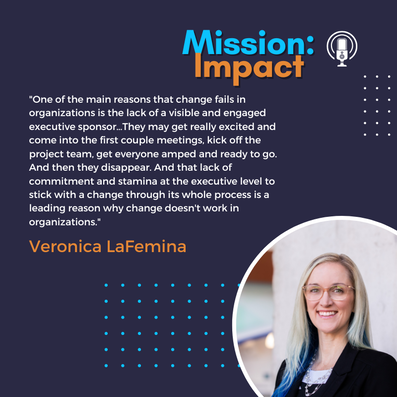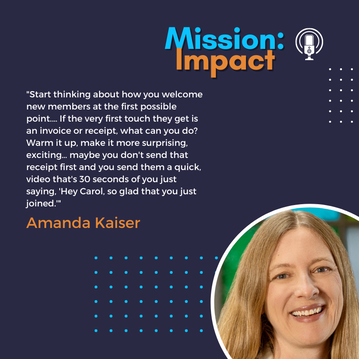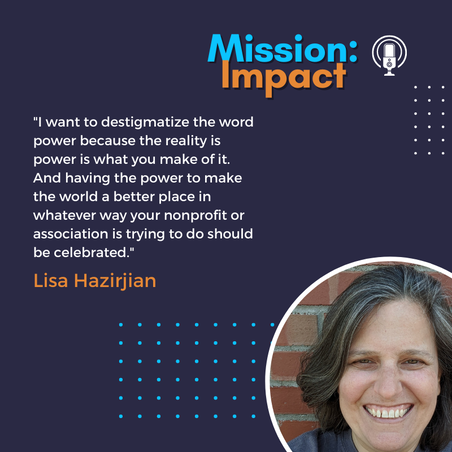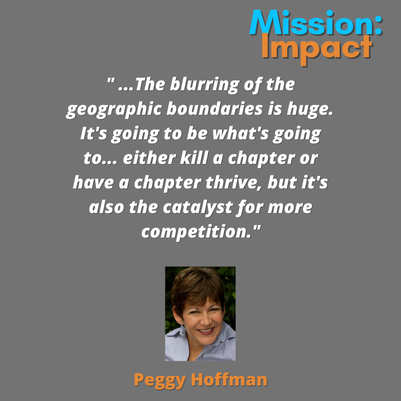Mission: Impact podcast & blog
Build a better world without becoming a martyr to your nonprofit cause
Listen on:
 In episode 74 of Mission: Impact, Carol Hamilton and her guest, Veronica LaFemina discuss
Guest Bio: Veronica LaFemina is Founder and CEO of LaFemina & Co., an advisory firm supporting nonprofits and social impact businesses at the intersection of strategy, culture, communications, and change management. Veronica partners with organizations and their leaders to go beyond what “looks good on paper” to focus on what works well in real life. She is a leader, strategist, facilitator, trusted advisor, and certified change management professional with nearly two decades of experience as a senior executive at national U.S. nonprofit organizations and a high-impact consultant. Her work has been featured by Inc. Magazine, the Today Show, NPR, CNN, Capterra, and in news outlets nationwide. Important Links and Resources:
Click "Read More" for Transcript:  In episode 68 of Mission: Impact, Carol and her guest, Amanda Kaiser discuss:
Amanda Kaiser is a member engagement strategist and author of Elevating Engagement: Uncommon Strategies for Creating Thriving Member Communities. As a researcher, author, and co-creator of the Incubator Series and the New Member Engagement Study, she is at the forefront of exploring how member and attendee engagement is rapidly changing within professional communities. Important Links and Resources:
Click "Read More" for Transcript:  In episode 65 of Mission: Impact, Carol and her guest, Lisa G. Hazirjian discuss: ● Some common mistakes and misconceptions nonprofits have about policy advocacy ● Simple steps to take to get to know policy makers better and build relationships ● How to build a ladder of engagement for your supporters and volunteers Guest Bio: Lisa Hazirjian, PhD, founded Win Together Consulting to help progressive change makers develop strategy, build power, engage supporters, and leverage strengths to achieve their goals. She holds a Bachelor of Arts in Public Policy Studies, Graduate Certificate in Women’s Studies, and Ph.D. in U.S. History from Duke University, and is working toward a Nonprofit Leadership Certificate from the Harvard Kennedy School. You can reach Lisa at lisa@wintogetherconsulting.com. Important Links and Resources: ● Win Together Consulting https://www.linkedin.com/in/lisahazirjian/ Click "Read More" for Transcript:  In episode 28 of Mission: Impact, some of the topics that Carol and her guest, Peggy Hoffman discussed include:
Peggy Hoffman is president of Mariner Management, an association management company which is home to two associations and provides an array of support and training to associations and most importantly member volunteers. Peggy has provided training and counsel to dozens of global, national and local membership associations over the past 30 years. She often draws on her own team’s research on volunteerism, member communities and association innovation. Peggy not only enjoys working with association volunteers but is an active volunteer for her professional association – including serving as a chapter past president – so she’ll draw from experience on both levels. Read her full bio at MarinerManagement.com and connect with Peggy on Twitter @peggyhoffman or LinkedIn. And ask her about triathlons, dance or living with three sons. Important Guest Links:
Click "Read More" for Transcript: |
Archives
April 2024

Grace Social Sector Consulting, LLC, owns the copyright in and to all content in and transcripts of the Mission: Impact podcast, as well as the Mission: Impact blog with all rights reserved, including right of publicity.
|
Telephone301-857-9335
|
info[at]gracesocialsector.com
|
Grace Social Sector Consulting, LLC, owns the copyright in and to all content in, including transcripts and audio of the Mission: Impact podcast and all content on this website, with all rights reserved, including right of publicity.
|